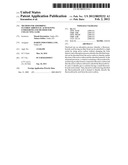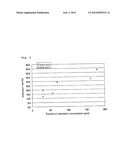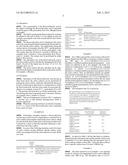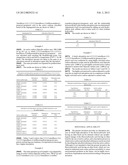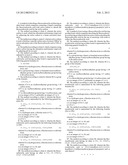Patent application title: METHOD FOR ADSORBING FLUOROCARBOXYLIC ACID HAVING ETHER BOND AND METHOD FOR COLLECTING SAME
Inventors:
Masaki Kuramitsu (Osaka, JP)
Takuya Ichiba (Osaka, JP)
Assignees:
DAIKIN INDUSTRIES LTD.
IPC8 Class: AC07C5142FI
USPC Class:
562580
Class name: Acyclic oxy purification or recovery per se
Publication date: 2012-02-02
Patent application number: 20120029232
Abstract:
Disclosed are an adsorption process whereby a fluorocarboxylic acid
having an ether bond can be adsorbed to a high extent by using active
carbon without changing the form thereof, and a desorption process
whereby the adsorbed material can be desorbed from the active carbon to
thereby enable the reuse of the active carbon and the adsorbed material.
In the aforesaid processes, a solution containing a fluorocarboxylic acid
having an ether bond is contacted with active carbon and thus the active
carbon is allowed to adsorb the fluorocarboxylic acid, to thereby give a
solution having a small fluorocarboxylic acid content. Then, the active
carbon having adsorbed the fluorocarboxylic acid is heated to thereby
desorbs the fluorocarboxylic acid from the active carbon.Claims:
1. A method of adsorbing a fluorocarboxylic acid having an ether bond,
which comprises contacting a liquid containing the fluorocarboxylic acid
with active carbon to adsorb the fluorocarboxylic acid by the active
carbon.
2. The method according to claim 1, wherein the active carbon is used, which has adsorption performance improved by subjecting the active carbon to a steam activation treatment.
3. The method according to claim 1, wherein active carbon is used, which has a specific surface area of at least 1500 m2/g and an adsorption rate of the fluorocarboxylic acid of 10% or more.
4. The method according to claim 1, which comprises using active carbon having the adsorption performance improved by adjusting pH by an acid.
5. The method according to claim 1, wherein the pH is adjusted to at most 4.
6. The method according to claim 1, wherein the fluorocarboxylic acid having an ether bond is represented by the following general formula (I): X--Rf-COOH (I) wherein X is a hydrogen atom, a fluorine atom or a chlorine atom, and Rf is a group having a linear or branched monooxyfluoroalkylene group or polyoxyfluoroalkylene group having 4-20 carbon atoms.
7. The method according to claim 6, wherein Rf is a group of the formula: -A1O-(A2O)n-A3- wherein A1O is an oxyfluoroalkylene group having 1-10 carbon atoms, A2O is an oxyfluoroalkylene group having 2-5 carbon atoms, A3 is a fluoroalkylene group having 1-4 carbon atoms, and n is an integer of 0 to 5, preferably an integer of 1 to 4.
8. The method according to claim 1, wherein the fluorocarboxylic acid is represented by the following general formula (II): X--(CF2)m--O--(CF(CF3)CF2O)n--CF(--Y)(CF2).- sub.pCOOH (II) wherein X is a hydrogen atom, a fluorine atom or a chlorine atom, Y is a hydrogen atom, a fluorine atom or CF3, m is an integer of 1 to 10, n is an integer of 0 to 5, and p is 0 or 1.
9. The method according to claim 1, wherein the fluorocarboxylic acid is represented by the following formula (IIa) or (IIb): X--(CF2)m--O--(CF(CF3)CF2O)n--CF(CF3)COOH (IIa) wherein X is a hydrogen atom, a fluorine atom or a chlorine atom, m is an integer of 1 to 10, and n is an integer of 0 to 5, or X--(CF2)m--O--(CF(CF3)CF2O)n--CHFCF2COOH (IIb) wherein X is a hydrogen atom, a fluorine atom or a chlorine atom, m is an integer of 1 to 10, and n is an integer of 0 to 5.
10. The method according to claim 1, wherein the fluorocarboxylic acid having an ether is CF3--O--CF(CF3)CF2O--CF(CF3)COOH.
11. The method according to claim 1, wherein the fluorocarboxylic acid is 2,3,3,3-tetrafluoro-2-[1,1,2,3,3,3-hexafluoro-2-(trifluoromethoxy)propoxy- ]-propanoic acid or salts thereof.
12. A method of recovering a fluorocarboxylic acid having an ether bond, which comprises desorbing the fluorocarboxylic acid having an ether bond from active carbon adsorbing the fluorocarboxylic acid by the use of azeotropy with water to collect the fluorocarboxylic acid.
13. The method according to claim 12, wherein the fluorocarboxylic acid having an ether bond is represented by the following general formula (I): X--Rf-COOH (I) wherein X is a hydrogen atom, a fluorine atom or a chlorine atom, and Rf is a group having a linear or branched monooxyfluoroalkylene group or polyoxyfluoroalkylene group having 4-20 carbon atoms.
14. The method according to claim 12, wherein Rf is a group of the formula: -A1O-(A2O)n-A3- wherein A1O is an oxyfluoroalkylene group having 1-10 carbon atoms, A2O is an oxyfluoroalkylene group having 2-5 carbon atoms, A3 is a fluoroalkylene group having 1-4 carbon atoms, and n is an integer of 0 to 5, preferably an integer of 1 to 4.
15. The method according to claim 12, wherein the fluorocarboxylic acid is represented by the following general formula (II): X--(CF2)m--O--(CF(CF3)CF2O)n--CF(--Y)(CF2).- sub.pCOOH (II) wherein X is a hydrogen atom, a fluorine atom or a chlorine atom, Y is a hydrogen atom, a fluorine atom or CF3, m is an integer of 1 to 10, n is an integer of 0 to 5, and p is 0 or 1.
16. The method according to claim 12, wherein the fluorocarboxylic acid is represented by the following formula (IIa) or (IIb): X--(CF2)m--O--(CF(CF3)CF2O)n--CF(CF3)COOH (IIa) wherein X is a hydrogen atom, a fluorine atom or a chlorine atom, m is an integer of 1 to 10, and n is an integer of 0 to 5, or X--(CF2)m--O--(CF(CF3)CF2O)n--CHFCF2COOH (IIb) wherein X is a hydrogen atom, a fluorine atom or a chlorine atom, m is an integer of 1 to 10, and n is an integer of 0 to 5.
17. The method according to claim 12, wherein the fluorocarboxylic acid having an ether is CF3--O--CF(CF3)CF2O--CF(CF3)COOH.
18. The method according to claim 12, wherein the fluorocarboxylic acid is 2,3,3,3-tetrafluoro-2-[1,1,2,3,3,3-hexafluoro-2-(trifluoromethoxy)prop- oxyl-propanoic acid or salts thereof.
Description:
FIELD OF THE INVENTION
[0001] The present invention relates to a method of adsorbing a fluorocarboxylic acid having an ether bond, in which the fluorocarboxylic acid having an ether bond contained in a liquid phase is capable of being highly collected, and a method of recovering the fluorocarboxylic acid, in which the fluorocarboxylic acid is capable of being highly recovered from an active carbon.
[0002] According to the present invention, it is capable of efficiently and selectively recovering the fluorocarboxylic acid having an ether bond from a liquid phase, such as waste water from a plant, waste water from households and rivers. In addition, it is capable of recycling active carbon and recovering the adsorbed substances by desorbing the adsorbed substances from the active carbon which has adsorbed.
BACKGROUND OF THE INVENTION
[0003] A fluorocarboxylic acid having an ether bond, for example, 2,3,3,3-tetrafluoro-2-[1,1,2,3,3,3-hexafluoro-2-(trifluoromethoxy)propoxy- ]-propanoic acid has a solubility in water of about 10% at normal temperature, which is about 50 times of the solubility of perfluorooctanoic acid (PFOA) in water. Therefore, the adsorption rate of general active carbon, for example, general-purpose active carbon for waste water which was conventionally used is 5% or less at normal temperature and pH 7.
[0004] It was difficult to highly adsorb the fluorocarboxylic acid having an ether bond, which has high solubility in water, with using the conventional active carbon having a specific surface area of 1,000 m2/g or less. Such adsorption method was associated with problems of cost. [0005] Patent Document 1: JP-A-09-315809
DISCLOSURE OF THE INVENTION
Problems to be Solved by the Invention
[0006] An object of the present invention is to provide a method of highly adsorbing a fluorocarboxylic acid having an ether bond and a method of recovering the fluorocarboxylic acid.
Means for Solving the Problem
[0007] The present invention is based on the fact that the fluorocarboxylic acid having an ether bond is highly adsorbed by an active carbon which has been subjected to a particular treatment.
[0008] The present invention provides a method of adsorbing a fluorocarboxylic acid having an ether bond, wherein the fluorocarboxylic acid is adsorbed by an active carbon by contacting a liquid containing the fluorocarboxylic acid with the active carbon. The method of adsorbing the fluorocarboxylic acid may be used for a method of treating a liquid which contains the fluorocarboxylic acid.
[0009] The present invention further provides a method of desorbing the fluorocarboxylic acid having an ether bond without decomposition of the fluorocarboxylic acid, wherein the fluorocarboxylic acid is desorbed from the active carbon by heating the active carbon, which has adsorbed the fluorocarboxylic acid, to a temperature of 99° C. to 145° C.
[0010] It is capable to recover the fluorocarboxylic acid by collecting the desorbed fluorocarboxylic acid.
Effect of the Invention
[0011] According to the present invention, it is capable to highly adsorb the fluorocarboxylic acid having an ether bond. In the desorbing process, it is capable to recycle the active carbon by heating the active carbon to a temperature of 99° C., which is suitable for desorption by azeotropy with water and avoids heat decomposition of the fluorocarboxylic acid having an ether bond. It is capable to recycle the fluorocarboxylic acid by collecting and concentrating the desorbed fluorocarboxylic acid.
BRIEF DESCRIPTION OF THE DRAWING
[0012] FIG. 1 is a graph showing the relationship between an adsorption rate and an equilibrium concentration in the cases using a high activation active carbon adjusted to hydrochloric acid acidity and a high activation active carbon adjusted to neutral prepared in Example 5.
MODE OF CARRYING OUT THE INVENTION
[0013] Preferably, in the present invention, the active carbon is highly activated in order to improve the physical adsorptivity of the active carbon and the specific surface area of the active carbon is increased to 1500 m2/g or more. Preferably, the chemical adsorptivity of the active carbon is also improved by impregnating the surface of the active carbon with an ion. The adsorption rate of the active carbon can be improved to 100 or more, for example 20% or more.
[0014] The adsorption rate (%) is given by:
[[(Concentration of fluorocarboxylic acid in initial raw water [ppm])-(Concentration of fluorocarboxylic acid in treated water after adsorption [ppm])]×(Amount of raw water [g])]/[(Amount of used active carbon [g])×1,000,000]×100 [%].
[0015] The active carbon to be used for the present invention can be produced from carbonaceous materials. As the carbonaceous material, a material which produces an active carbon by carbonization or activation can be used. Such material includes, for example, materials of plant origin such as woods, sawn wood, charcoal, coconut shell, fruit shell such as walnut shell and seeds of fruits; materials of mineral origin, for example, coal such as peat, lignite, brown coal, bituminous coal and anthracite coal, pitch such as petroleum pitch and coal pitch, cokes, tar such as coal tar and petroleum tar, petroleum distillates residues; natural materials, for example, cellulosic fiber such as cotton and rayon, and synthetic materials such as phenolic resin, polyvinyl alcohol and polyacrylonitrile. The form of the active carbon and the carbonaceous material includes powder form, granular form, fibrous form and any form which is prepared by molding the material.
[0016] An active carbon can be produced from the carbonaceous material by subjecting the carbonaceous material to a treatment such as carbonization or activation. The carbonization may be performed by, for example, heat retorting the carbonaceous material at a temperature between about 300 and 700° C. The activation may be performed by, for example, medicament activation using, for example, zinc chloride, phosphoric acid, sulfuric acid, calcium chloride, sodium hydroxide or potassium hydroxide, gas activation using, for example, steam, carbon dioxide, oxygen gas, combustion exhaust gas or a mixture gas thereof. The size of the active carbon is generally in a range between 0.5 and 5.0 mm. Specific surface area of the active carbon can be increased by an activation. The active carbon preferably has a specific surface area of at least 1,500 m2/g, for example from 1,500 to 2,500 m2/g and particularly from 1,800 to 2,500 m2/g. In particular, the active carbon preferably has a specific surface area of at least 2000 m2/g.
[0017] Preferably, the active carbon has an improved adsorption performance by subjecting it to a steam activation treatment. Preferably, the active carbon is exposed to a steam at a temperature of at least 120° C., for example from 130 to 1000° C., particularly from 150 to 350° C. and at a pressure of at least 0.2 MPa, for example from 0.5 to 15 MPa and particularly from 1 to 15 MPa. The treatment time of the steam activation may be generally from 10 seconds to 50 hours, for example, from 10 minutes to 10 hours. During the activation, the active carbon may be heated in a furnace.
[0018] The surface of the active carbon may be impregnated with a cation. Examples of the cation include a metal ion, a metal oxide ion and an ammonium ion. Examples of the metal include a metal atom selected from Groups 1 to 13 of the Periodic Table of the Elements, for example, an alkaline metal (for example, Li, Na and K), an alkaline earth metal (for example, Mg and Ca), and Ti, Zr, V, Cr, Fe, Ni, Cu and Zn.
[0019] The high activation active carbon adjusted to acidic state (for example, hydrochloric acid acidity) is preferable. The acidic high activation active carbons can be produced by soaking, in an acid (particularly, hydrochloric acid), the active carbon which has been subjected to an activation treatment at a higher temperature than a general activation temperature and/or for a longer time than a general activation time. Alternatively the acidic high activation active carbons can be produced by flowing the acid through the active carbon.
[0020] The fluorocarboxylic acid having an ether bond may be a free form or a salt form.
[0021] Preferably the fluorocarboxylic acid having an ether bond is a carboxylic acid having an aliphatic group, particularly an aliphatic carboxylic acid having an aliphatic group (in particular, an alkyl group) which is partially or completely substituted with fluorine atoms. Particularly preferably, the fluorocarboxylic acid is a perfluorocarboxylic acid. Preferably the carbon atom of the fluorocarboxylic acid having an ether bond is from 5 to 30. Preferably, the fluorocarboxylic acid having an ether bond has a monooxyfluoroalkylene group (the number of oxyfluoroalkylene groups is 1.) or a polyoxyfluoroalkylene group (the number of oxyfluoroalkylene groups is two or more.) as an ether group. The number of oxyfluoroalkylene groups in the fluorocarboxylic acid may be from 1 to 10, particularly from 1 to 5. Preferably, the oxyfluoroalkylene group is a branched or linear chain and has 2-5 carbon atoms.
[0022] The fluorocarboxylic acid having an ether bond may be represented by the following general formula (I):
X--Rf-COOH (I)
wherein X is a hydrogen atom, a fluorine atom or a chlorine atom, and [0023] Rf is a group having a linear or branched monooxyfluoro-alkylene group or polyoxyfluoroalkylene group having 4-20 carbon atoms.
[0024] Rf is preferably a group of the formula:
-A1O-(A2O)n-A3-
wherein A1O is an oxyfluoroalkylene group having 1-10 carbon atoms, [0025] A2O is an oxyfluoroalkylene group having 2-5 carbon atoms, [0026] A3 is a fluoroalkylene group having 1-4 carbon atoms, and [0027] n is an integer of 0 to 5, preferably an integer of 1 to 4.
[0028] Preferably, A1O is an oxyperfluoroalkylene group, A2O is an oxyperfluoroalkylene group, and A3 is a perfluoroalkylene group. Preferably, the number of carbon atoms of Rf is from 4 to 14.
[0029] The fluorocarboxylic acid is preferably represented by the following general formula (II):
X--(CF2)m--O--(CF(CF3)CF2O)n--CF(--Y)(CF2)- pCOOH (II)
wherein X is a hydrogen atom, a fluorine atom or a chlorine atom, [0030] Y is a hydrogen atom, a fluorine atom or CF3, [0031] m is an integer of 1 to 10, [0032] n is an integer of 0 to 5, and [0033] p is 0 or 1.
[0034] Preferably n is from 1 to 4.
[0035] The fluorocarboxylic acid may be represented by the following formula (IIa) or (IIb):
X--(CF2)m--O--(CF(CF3)CF2O)n--CF(CF3)COOH (IIa)
wherein X is a hydrogen atom, a fluorine atom or a chlorine atom, [0036] m is an integer of 1 to 10, and [0037] n is an integer of 0 to 5, or
[0037] X--(CF2)m--O--(CF(CF3)CF2O)n--CHFCF2COOH (IIb)
wherein X is a hydrogen atom, a fluorine atom or a chlorine atom, [0038] m is an integer of 1 to 10, and [0039] n is an integer of 0 to 5.
[0040] Examples of the salt of the fluorocarboxylic acid include a metal salt, an ammonium salt and an amine salt. Examples of the metal salt include a salt of an alkaline metal, for example, lithium, sodium and potassium (Group 1 of the Periodic Table), or a salt of an alkaline earth metal, for example, calcium and magnesium (Group 2 of the Periodic Table).
[0041] Specific Examples of the fluorocarboxylic acid are as follows: [0042] 2,3,3,3-tetrafluoro-2-[1,1,2,3,3,3-hexafluoro-2-(trifluoromethoxy)- propoxy]-propanoic acid [CF3--O--(CF(CF3)CF2O)--CF(CF3)COOH], [0043] CHF2--O--(CF(CF3)CF2O)--CF(CF3)COOH, [0044] CF3--O--(CF(CF3)CF2O)2--CF(CF3)COOH, [0045] CF3--O--(CF(CF3)CF2O)2--CF(CF3)COOH, [0046] CF3--O--(CF(CF3)CF2O)--CHFCF2COOH, and [0047] CHF2--O--(CF(CF3)CF2O)3--CHFCF2COOH.
[0048] Specific examples of the salts of the fluorocarboxylic acid include an alkali metal salt and ammonium salt of the specific examples of the fluorocarboxylic acid, particularly ammonium 2,3,3,3-tetrafluoro-2-[1,1,2,3,3,3-hexafluoro-2-(trifluoromethoxy)propoxy- ]-propanoate salt.
[0049] The fluorocarboxylic acid generally one having a function as a surface active agent.
[0050] In the present invention, adsorption and desorption of the fluorocarboxylic acid can be performed with using an active carbon. The fluorocarboxylic acid can be recovered by desorbing the adsorbed substances such as the fluorocarboxylic acid from the active carbon.
(1) Adsorption
[0051] The concentration of the fluorocarboxylic acid in the liquid containing the fluorocarboxylic acid is generally from 0.01 ppm to 200, particularly from 10 to 100 ppm (based on weight).
[0052] The liquid containing the fluorocarboxylic acid may be adjusted to have pH of from 1 to 5 by adding an acid, for example, an inorganic acid such as hydrochloric acid, before the adsorption.
[0053] The fluorocarboxylic acid is adsorbed in the active carbon by contacting the liquid containing the fluorocarboxylic acid with the active carbon. The temperature during the contact may be, for example, from 0 to 50° C. and the pressure may be, for example, from 0.1 to 10 atm, particularly 1 atm. The contact time may be from 0.1 seconds to 100 hours, for example, from 1 second to 1 hour, particularly from 30 seconds to 1 minute. The contact may be performed by either batch or flow process.
[0054] The adsorption rate of the fluorocarboxylic acid to the active carbon can be controlled by changing the pH of the liquid. The pH of the liquid may be from 1.5 to 13.5, for example, from 2 to 13.
[0055] The active carbon that has adsorbed can be separated from the liquid containing the fluorocarboxylic acid by, for example, a filtration.
(2) Desorption
[0056] Desorption of the fluorocarboxylic acid having an ether bond (from the active carbon) can be performed by heating the active carbon, which has adsorbed the fluorocarboxylic acid having an ether bond, to a temperature at which the fluorocarboxylic acid and water make an azeotropic distillation, for example, at least 99° C., particularly 99 to 145° C. The pressure may be from 0.1 to 10 atm, particularly 1 atm. The heating time may be generally from 1 second to 10 hours, for example, from 1 minute to 2 hours.
[0057] The use of temperature of at least 150° C. might give a recovery loss so that thermal decomposition tends to become significant.
[0058] When the azeotrope mixture is cooled (for example, to 25° C.), a layer of the fluorocarboxylic acid is separated from a layer of water.
EXAMPLES
[0059] Hereinafter, examples wherein a fluorocarboxylic acid having an ether bond in a liquid phase is adsorbed by an active carbon and examples wherein the active carbon, which has adsorbed the fluorocarboxylic acid having an ether bond, is heated by a dryer so that the adsorbed substances is desorbed from the active carbon.
[0060] In some of the following examples, each of six types of active carbons having different specific surface areas, which were prepared from the same material (coconut shell), was used.
TABLE-US-00001 Specific Surface Area Product name General Carbon 1 1150 DIAHOPE M006 F-400, manufactured by Calgon Mitsubishi Chemical Corporation General Carbon 2 1180 Shirasagi WH, manufactured by Japan EnviroChemicals, Limited Highly Activated 2300 Kuraray Coal NK-261, manufactured by Carbon 1 Kuraray Chemical Co., Ltd. Highly Activated 2000 D-2000, manufactured by Calgon Carbon 2 Mitsubishi Chemical Corporation Highly Activated 1800 -- Carbon 3 Highly Activated 1500 -- Carbon 4
Example 1
[0061] Into a 500 cc glass bottle, each of active carbons (0.1 g) was charged and then 300 cc of aqueous solution containing 100 ppm of 2,3,3,3-tetrafluoro-2-[1,1,2,3,3,3-hexafluoro-2-(trifluoromethoxy)propoxy- ]-propanoic acid, which was adjusted to pH 2, was charged. The bottle was shaken at a temperature of 25° C. for 24 hours by a shaking apparatus, to adsorb 2,3,3,3-tetrafluoro-2-[1,1,2,3,3,3-hexafluoro-2-(trifluoromethoxy)propoxy- ]-propanoic acid by the active carbon. Then, an adsorption amount (an equilibrium amount of adsorption) was calculated from the concentrations of 2,3,3,3-tetrafluoro-2-[1,1,2,3,3,3-hexafluoro-2-(trifluoromethoxy)prop- oxy]-propanoic acid in the raw water and the treated aqueous solution. An adsorption rate of 2,3,3,3-tetrafluoro-2-[1,1,2,3,3,3-hexafluoro-2-(trifluoromethoxy)propoxy- ]-propanoic acid to each active carbon is shown in Table 1.
[0062] The adsorption rate (%) is given by:
[[(Concentration of 2,3,3,3-tetrafluoro-2-[1,1,2,3,3,3-hexafluoro-2-(trifluoromethoxy)propoxy- ]-propanoic acid in initial raw water [ppm])--(Concentration of 2,3,3,3-tetrafluoro-2-[1,1,2,3;3,3-hexafluoro-2-(trifluoromethoxy)-propox- y]-propanoic acid in treated water after adsorption [ppm])]×(Amount of raw water [g])]/[(Amount of used active carbon [g])×1,000,000]×100 [%].
TABLE-US-00002 TABLE 1 Types of Active Specific Surface Adsorption Carbon (coconut) Area [m2/g] Rate [%] Highly Activated 2300 25.4 Carbon 1 Highly Activated 2000 22.9 Carbon 2 Highly Activated 1800 19.5 Carbon 3 Highly Activated 1500 16.7 Carbon 4 General Carbon 1 1150 6.9 General Carbon 2 1180 7.8
[0063] As shown in Table 1, the fact that there is a relationship between the adsorption rate and the specific surface area is admitted. It was also admitted that the adsorption rate of active carbons reaches at least 20% , when the active carbons have a specific surface area of at least 1,800 [m2/g].
Example 2
[0064] The same operation as in Example 1 was repeated except for using an ion-impregnated active carbon (Specific surface area: 500 m2/g). The adsorption rates of 2,3,3,3-Tetrafluoro-2-[1,1,2,3,3,3-hexafluoro-2-(trifluoromethoxy)propoxy- ]-propanoic acid in the active carbons classified based on the impregnated ions are shown in Table 2.
TABLE-US-00003 TABLE 2 Impregnated Ion Adsorption Rate [%] MgO I 12.3 MgO II 13.7 Amines 16.7
Example 3
[0065] An active carbon (Specific surface area: 500-2,000 m2/g) (0.1 g), to which 2,3,3,3-tetrafluoro-2-[1,1,2,3,3,3-hexafluoro-2-(trifluoromethoxy)propoxy- ]-propanoic acid was adsorbed until reaching the breakthrough point, was charged into a dryer and left at a temperature of 99° C. for 48 hours. The desorption amount was taken as the same as an adsorption amount in adsorption again after the desorption.
[0066] The same procedure was repeated for perfluorohexanoic acid.
[0067] The results are shown in Tables 3 and 4.
TABLE-US-00004 TABLE 3 Adsorption and desorption amounts of 2,3,3,3-tetrafluoro-2-[1,1,2,3,3,3- hexafluoro-2-(trifluoromethoxy)propoxy]-propanoic acid by active carbon Adsorption Desorption Desorption rate Active carbon type amount amount [%] Highly Activated 0.0254 0.0151 59.4 Carbon 1 Highly Activated 0.0228 0.0144 63.2 Carbon 2 Highly Activated 0.0194 0.0094 48.5 Carbon 3 Highly Activated 0.0168 0.0077 45.8 Carbon 4 General Carbon 1 0.0068 0.0043 63.2 General Carbon 2 0.0078 0.0049 62.8
TABLE-US-00005 TABLE 4 Adsorption and desorption amounts of perfluorohexanoic acid by active carbon Adsorption Desorption Desorption rate Active carbon type amount amount [%] Highly Activated 0.0227 0.0117 51.5 Carbon 1 Highly Activated 0.0219 0.0121 55.3 Carbon 2 Highly Activated 0.0211 0.0074 35.1 Carbon 3 Highly Activated 0.0180 0.0059 32.8 Carbon 4 General Carbon 1 0.0085 0.0038 44.7 General Carbon 2 0.0081 0.0034 42.0
[0068] Tables 3 and 4 shows that 2,3,3,3-tetrafluoro-2-[1,1,2,3,3,3-hexafluoro-2-(trifluoromethoxy)propoxy- ]-propanoic acid having easy tendency of evaporation in azeotrope has a higher desorption.
Example 4
[0069] The same operation as in Example 1 was repeated by using an active carbon (Specific surface area: 700 m2/g) and 2,3,3,3-tetrafluoro-2-[1,1,2,3,3,3-hexafluoro-2-(trifluoromethoxy)propoxy- ]-propanoic acid, and the relationship between the pH value and the adsorption rate was determined. Adjustment of pH was performed by adding an acid (hydrochloric acid, sulfuric acid or nitric acid) or a base (sodium hydroxide).
[0070] The results are shown in Table 5.
TABLE-US-00006 TABLE 5 pH Adsorption Rate [%] 2.0 6.9 11.0 1.8
Example 5
[0071] A batch adsorption test of 2,3,3,3-tetrafluoro-2-[1,1,2,3,3,3-hexafluoro-2-(trifluoromethoxy)propoxy- ]-propanoic acid was conducted by using highly activated active carbon adjusted to acidic state by hydrochloric acid (Specific surface area: 2,000 m2/g) and highly activated active carbon adjusted to neutral state (Specific surface area: 2,000 m2/g).
[0072] The results are shown in Tables 6 and 7 and FIG. 1.
[0073] The highly activated active carbon adjusted to acidic state has an improved adsorption rate in comparison with the highly activated active carbon adjusted to neutral state.
TABLE-US-00007 TABLE 6 Adsorption performance of highly activated active carbon adjusted to neutral state Equilibrium Adsorption Active carbon concentration [ppm] rate [%] amount [g] pH 30.1 11.8 0.1 3.6 57.4 15.9 0.1 3.6 162.4 32.8 0.1 3.6
TABLE-US-00008 TABLE 7 Adsorption performance of highly activated active carbon adjusted to acidic state Equilibrium Adsorption Active carbon concentration [ppm] rate [%] amount [g] pH 30.4 19.6 0.1 3.6 70.1 28.9 0.1 3.6 179.5 43.2 0.1 3.6
INDUSTRIAL APPLICABILITY
[0074] The present invention provides an adsorption process in which high adsorption of the fluorocarboxylic acid having an ether bond can be attained without any morphological change of the fluorocarboxylic acid having an ether bond by the use of active carbon, and a desorption process in which active carbon and adsorbed substances can be recycled by desorbing the adsorbed substances from the active carbon. Although it is not intended to limit the present invention, the fluorocarboxylic acid having an ether bond, which are contained in industrial waste water and have possibility to cause environmental problems in the future, can be highly recovered from a liquid phase and recycled according to the present invention.
User Contributions:
Comment about this patent or add new information about this topic:
| People who visited this patent also read: | |
| Patent application number | Title |
|---|---|
| 20210326341 | SYSTEMS, METHODS, AND DEVICES FOR MANAGING DATA SKEW IN A JOIN OPERATION |
| 20210326340 | SYSTEM AND METHOD FOR DISJUNCTIVE JOINS |
| 20210326339 | Data Analysis Platform Utilizing Database Relationships to Visualize Data |
| 20210326338 | AUTOMATED EXTRACTION OF DATA FROM WEB PAGES |
| 20210326337 | METHOD AND SYSTEM FOR KEYWORD SEARCH OVER A KNOWLEDGE GRAPH |

